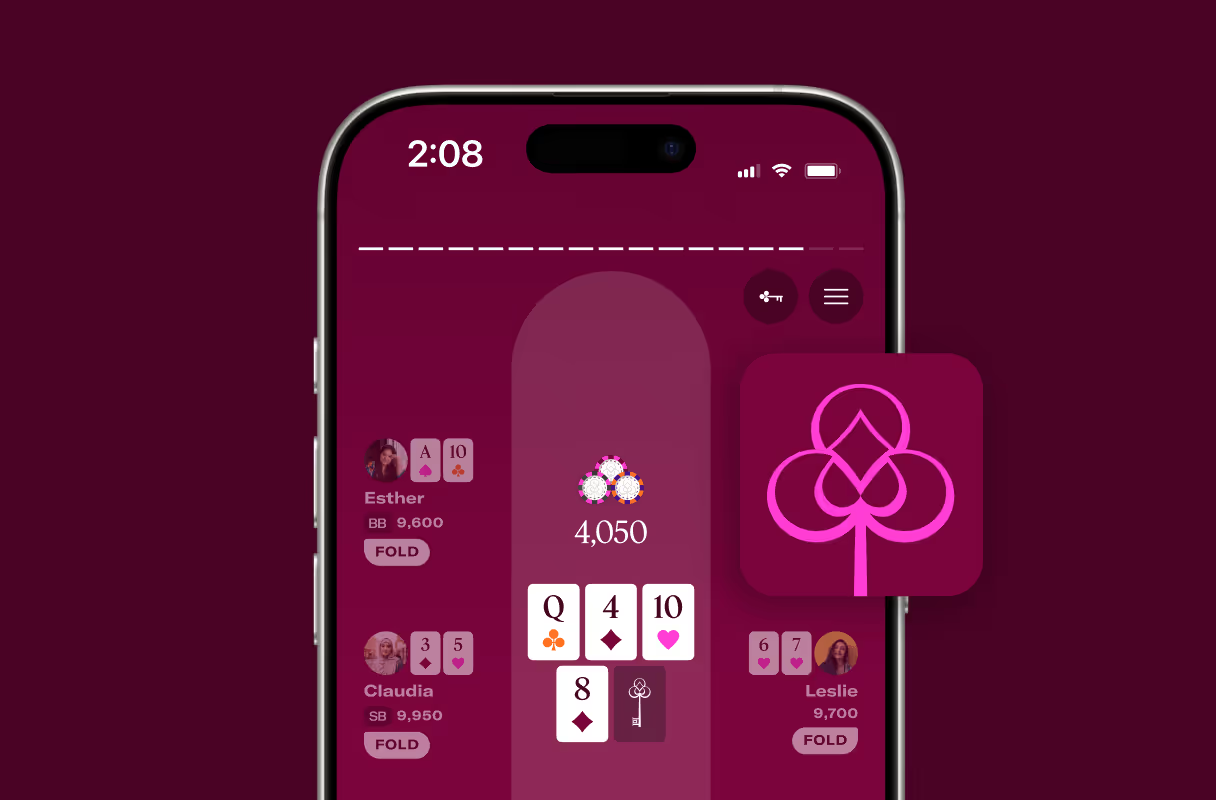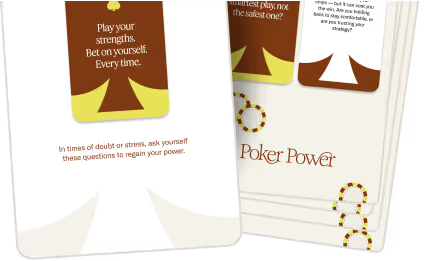After learning the rules to No Limit Hold’ em, you may be wondering how to approach the game’s strategy. Poker is as strategically rich as you make it - we offer classes for women on concepts basic to advanced. But to get you started thinking about poker strategy the right way, here are five tips to harness the power of poker and take your game to the next level.
1. Bet with purpose
In any poker game, a bet is made to achieve a specific goal. The two most common reasons to bet are to get called by a worse hand or to make a better hand fold. Other purposes can be to protect a vulnerable hand, remain unpredictable, or to prevent opponents from making a bigger bet.
Too often beginners will bet on middling strength hands without a reason to back up their decision. Usually this results in a game theory disaster - a situation where you maximize potential losses without increasing potential gains.
So before you release chips from your hand, think “how could my opponent respond to this bet with the different hands they may have?” If some outcomes are favorable, you can determine the purpose of your bet. If you can’t explain the purpose of your bet, you’re probably better off checking.
2. Enter the pot with a raise unless another player has already raised
Many beginning poker players enter pots by calling to see whether they make a strong hand before committing serious chips. While this is a natural instinct, the superior play is to enter the pot with a raise (say, three times the big blind).
The primary reason to raise rather than call is that you give yourself the opportunity to win the hand and collect the blinds uncontested. If you just call, the big blind will have a chance to beat you without committing any extra chips.
Another reason to raise is that you build bigger pots. This is advantageous because as the raiser you will naturally have stronger hands that are more likely to win pots than your opponents who only call. Having raised, the pots you’re favored in will be larger.
Finally, by raising any time you enter the pot you can remain unpredictable. If you raise the times you have premium hands like pocket aces but call the times you have marginal hands like 6/5 suited, your opponents can read into your actions to outplay you. By raising with every hand you want to play, you keep your opponents guessing and maximize your ability to bluff on every runout of community cards.
3. The fewer players remain in the hand the more aggressively you should play
This concept may be intuitive, but some beginners can forget amid the excitement of a big pot. A bet into five opponents signals greater strength than the same bet into just one opponent. This is because the chance that an opponent made a strong hand is greater the more opponents are in the pot.
This rule also translates to play before the flop. Raising with eight players left to act risks your chips against the potential for any of those eight players to start with a powerful hand. Raising with one player left poses a much smaller risk.
Therefore you should be more selective with which hands you play with eight players left to act (say, only play the best 10% of hands you’re dealt) as compared to the hands you play with just one player left to act (where you can play 70% of the hands you’re dealt or more!).
You’ll pick up the nuances of how to adjust your play simply by playing a bunch. Or if you want to expedite your learning, you can sign up for a private lesson with one of our instructors.
4. The size of the bet you face determines how often you need to call
When you call any bet on the river, you should expect to lose more often than you win. Why? Because you’re being given odds on your call! If your opponent bets 100 chips into a pot of 100 chips, you will profit 200 chips when you win but only lose 100 chips when you lose the hand.
Any time you face a bet, think about how much your opponent is risking to win what’s already in the middle. If they bet 20 chips into a pot of 100, you have to call very often to prevent them from stealing the pot for so little risk. However, if your opponent bets 200 chips into a pot of 100, you can mainly fold and only occasionally call because they risk comparatively so much.
The same logic applies when you are betting: the smaller you bet, the more often you need to have a value hand. This is because when you bet small, your opponent is risking little in comparison to what they could win, so you need to make sure that they win infrequently to discourage them from simply calling every time.
5. Any time you bet, consider both the value hands and the bluffs you could have
In order to win the pot most often, get called when you have good hands, and get folds when you’re bluffing, it’s important to have a mix of value hands and bluffs any time you bet.
Usually it’s easy to figure out the value hands you want to use - you just bet with the strongest hands you can have in that situation. However, when it comes to choosing the best hands to bluff with, here are the factors you should consider:
Which hands have the best chance to improve
Ideally your bluff can turn into a strong hand later on (i.e flush draws or two way straight draws)
Which hands have the least chance to win unimproved
Ideally your bluff is so weak that your opponent will fold an array of hands stronger than your bluff (i.e bluffing with unpaired hands ten-high or lower)
Which hands make it less likely your opponent will have a strong hand
Ideally you have cards your opponent would need to make a strong hand (i.e bluffing with the ace of spades when three of the community cards are spades.)
These concepts will give you a leg up on other beginners, but there’s much more to learn! If you’re interested in exploring the game of poker with a club of like minded peers, enroll in our classes. We’re committed to teaching 1,000,000 women poker strategy to bring more women to the table in business and poker. Take your seat at the table and experience the power of poker.





